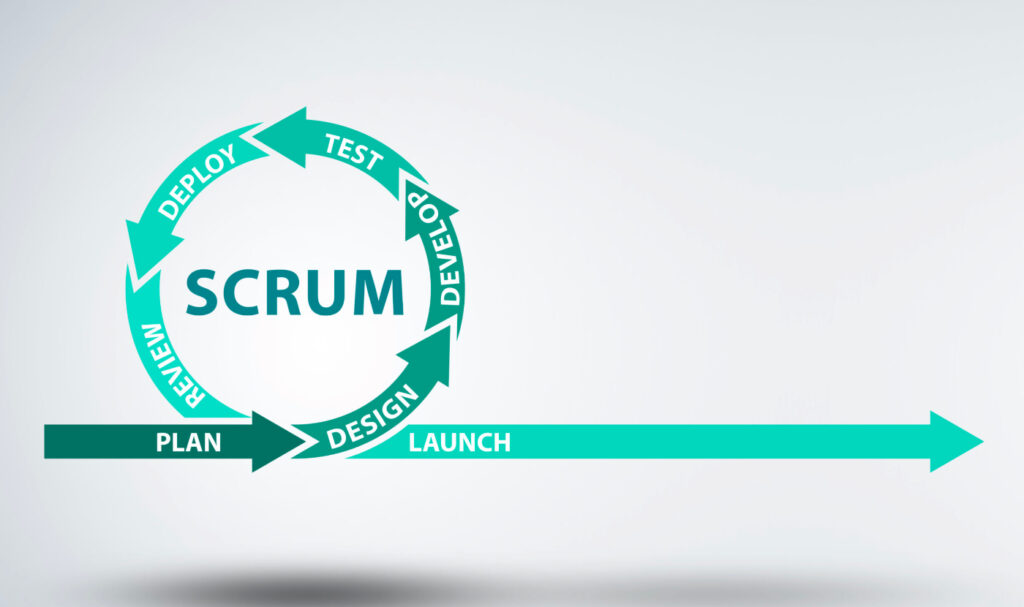Estimated reading time: 15 minutes
Whether you’re new to project management or have been doing it for years, understanding the top project management methodologies can give you a leg up in managing your projects.
Using any of these standard project methodologies can make your efforts to get the work done more efficient and even increase efficiency across the organization.
With the growing complexity of projects, particularly those in business, a project manager often relies on established methodologies to achieve consistency and predictability — hopefully resulting in streamlined processes, enhanced collaboration, and desired outcomes.
Table of Contents
- What are Project Management Methodologies?
- Why Are There So Many Methodologies?
- Top Project Management Methodologies
- Waterfall Methodology
- Agile Methodology
- Scrum Methodology
- Lean Methodology
- PRINCE2 Methodology
- Critical Path Methodology
- Critical Chain Project Management
- Six Sigma Methodology
- Extreme Programming (XP) Methodology
- How to Choose the Right Project Management Method?
- Final Thought
Below, you’ll find the top project management methodologies widely adopted by project management professionals worldwide. From Waterfall’s structured precision to Agile’s flexible adaptability and the middle-ground of Hybrid methodologies, we will explore how these diverse systems can be applied effectively in different project environments.
It’s important to note that this list is not ranked based on favorites or best-of. At Leantime, we believe that the best project management methods include a hybrid approach and should be organization-specific.
More: Discover features to get you from idea to reality.
When you or a project manager are familiar with these options, you can take the best of each and find which is the right project management methodology that works best for you and your project teams.
What are Project Management Methodologies?
Project management is a crucial component of any successful operation. A project management methodology is a structured approach to planning, executing, and managing projects. Project managers utilize methodologies to lead teams and manage work while encouraging collaboration effectively.
There are several popular project management methodologies, each with its own set of pros and cons. Choosing the right methodology for your project is more like picking the perfect outfit for an occasion – it depends on the nature of the project, the industry you’re in, and what your organization prefers.
That’s why it’s so important to get a good grasp on the various methodologies available and how each of them works. Understanding their unique applications, you can pinpoint the one that fits your project like a glove, ensuring it runs smoothly and successfully.
In occupations like software development, marketing, research and development, and product creation, the way they manage projects is a big deal. That’s why we’re closely examining some of the most popular project management methodologies out there.
Read More: Startup Project Management: The Key to Success
Our goal? To give you all the info, you need to make a smart choice that will guide your project straight to success. Whether you’re a seasoned pro or a startup, this deep dive into project management methods will shed some light on the best path for your project.
Why Are There So Many Methodologies?

Every project is unique in its own way, even if we replicate our past successes using project templates. Considering the varying objectives, KPIs, and methods used by different teams and industries, it’s pretty clear why a cookie-cutter approach to managing projects just doesn’t cut it.
Think of it this way: a slam-dunk strategy for one team might be a total flop for another. It’s all about finding what fits your team’s style and needs the best, which means the world of project management is as diverse as the projects themselves.
Top Project Management Methodologies
If you manage projects, you need to learn about project management methodologies. Here are the top project management methodologies that you can consider for your next project.
Waterfall Methodology
The waterfall methodology, also known as software development life cycle (SDLC) is a traditional and linear approach to project management, which is also the most straightforward of all the methods in this list. As the name suggests, the project phases flow downwards in this methodology. Each stage in the project must be fully completed before moving on to the next.
Typically, the stages in Waterfall project management go as follows:
- Requirements Gathering
- Analysis
- Design
- Construction or Development
- Testing
- Deployment and Maintenance
This approach provides a clear structure and allows for a comprehensive understanding of the project scope upfront. In many ways, this creates a feeling of control and project security.
One of the key advantages of using the waterfall approach is the clear structure it offers upon completion. Its sequential design simplifies the process, making it straightforward for both the project team and stakeholders to understand and follow.
However, a notable drawback of Waterfall project management is its limited flexibility. Making changes or adjustments during the project’s lifecycle can be difficult, as accommodating modifications after completing a phase poses significant challenges.
The detailed nature of the Waterfall model enables more precise estimations of project timelines and costs. This accuracy is beneficial in sectors with strict compliance, regulatory demands, or contractual obligations, where a thoroughly documented and predictable process is essential.
Keep in mind that waterfall project management is best suited for projects that will require little change, are predictable in nature, and are easy to define.
When to Use Waterfall Methodology?
The Waterfall approach excels in highly structured environments like manufacturing and construction, where changes after the fact are costly. It’s well-suited for projects that require a set path with little room for deviation. Waterfall often relies on Gantt charts for clear, visual organization when planning and scheduling these projects.
Agile Methodology
Agile is a project management methodology that’s a dynamic and collaborative approach that helps teams to self-organize. When adopting the agile methodology, project planning and work management are flexible, adaptable, and aimed at early delivery.
The process is continuously evolving and open to change, provided that it leads to process improvement. Unlike waterfall project management, agile project management is fast and flexible. Agile promotes close collaboration between team members, frequent client involvement, and prioritization of deliverables based on customer value.
Did You Know: The Agile project management methodology is one of the most common project management processes.
According to Organize Agile, the advantages of adopting Agile include enhanced flexibility and agility (reported by 83% of respondents), better financial outcomes (68%), and the development of a more open and productive workplace culture (noted by 61%).
The concept of agile project management has led to the creation of several sub-frameworks and methodologies, such as Scrum, Lean, and Kanban methodology.
In agile, projects are divided into small, manageable units called iterations or sprints, typically lasting from one to four weeks. Each sprint consists of planning, executing, and reviewing activities, allowing for frequent feedback and course correction.
The project team, including developers, testers, and stakeholders, work closely together in a highly collaborative and cross-functional manner. This promotes effective communication, transparency, and a shared understanding of project goals.
Over the years, more and more criticism has come out around the level of agility that comes from this methodology. Agile requires a commitment to the process, and steps may be missed for the sake of agility, losing track of high-level strategies because of the goal to be in constant movement.
When to Use Agile Methodology?
Agile project management has proven effective in this sphere, initially emerging from the software development world. It’s been successfully implemented in various fields that thrive on innovation and deal with uncertainty, including technology, automotive, healthcare, food, fashion, music, and more.
Agile is also increasingly popular in projects requiring a rapid and adaptable production schedule, like in marketing. This approach is ideal for environments where responsiveness and speed are critical.
Scrum Methodology

Scrum is a short “sprint” approach to managing projects. It’s a subset of the Agile project management framework and offers a structured yet flexible framework for managing complex projects. It focuses on self-organization, frequent communication, and ongoing improvement. Teams of up to 10 people often use two-week cycles with short daily meetings, known as daily scrum meetings.
Scrum’s iterative approach allows teams to swiftly adapt to changes, potentially reducing the risk of failure. However, its effectiveness hinges on strict adherence to its practices and a high level of team discipline.
It may not suit projects with a fixed scope or tight deadlines and relies heavily on strong team communication and collaboration. Implementing Scrum can also mean a significant shift in organizational culture, demanding a commitment to iterative development and continuous improvement.
In 1986, Hirotaka Takeuchi and Ikujiro Nonaka introduced the term “scrum” in an article published in the Harvard Business Review. Later, in 2001, Ken Schwaber and Mike Beedle wrote the book “Agile Software Development with Scrum,” which included Scrum as a part of the agile methodology. Schwaber established the Scrum Alliance in 2002, providing a certified Scrum accreditation program.
However, Scrum also has its drawbacks. One challenge is that Scrum requires high discipline and adherence to its practices and ceremonies. Without proper implementation, teams can easily deviate from the Scrum framework, which can greatly diminish its effectiveness.
Another potential con is that Scrum may not be suitable for all types of projects. It works best for projects with uncertain or evolving requirements but may not be ideal for projects with fixed scope or strict deadlines.
When to Use Scrum Methodology
Similar to Agile, Scrum has predominantly been used in software development. Yet, it’s versatile enough to be effective in various fields, from retail logistics to event planning or any project needing flexibility. However, it does necessitate adherence to specific Scrum roles.
Lean Methodology
Lean project management, as its name suggests, is about minimizing waste to maximize value in projects and manufacturing processes. It aims to streamline critical processes, enhancing the value stream by optimizing different technologies, assets, and sectors.
The roots of Lean project management can be traced back to Henry Ford’s assembly line, which revolutionized car manufacturing. The Lean methodology eliminates waste and maximizes value delivery. Toyota later expanded on this concept, applying it to manufacturing and continuous product development improvement.
The methodology encourages collaboration and cross-functional teams, enabling better communication and knowledge sharing among team members. Additionally, lean project management promotes faster project delivery through the use of agile practices and iterative approaches.
However, there are some challenges associated with this project management tool. Like Agile & Scrum, It requires a high level of discipline and commitment from the team to consistently adhere to the lean principles and practices.
When to Use Lean Methodology
Its principles have been embraced by various other industries, including construction and education, as well as numerous startups and software development companies. These sectors are attracted to Lean’s emphasis on end-user-focused products, demonstrating its versatility beyond its manufacturing roots.
PRINCE2 Methodology

PRINCE2 (Projects IN Controlled Environments) is a process-based methodology that is popular in the UK and gaining global recognition. This project management methodology offers a structured approach to managing projects, focusing on meticulous planning, controlled execution, and effective communication. PRINCE2 breaks projects into manageable stages, with clear roles and deliverables, and encourages regular reviews to track progress and risks.
A key advantage of PRINCE2 is its structured framework, which aids in precise project planning and execution. It promotes regular reviews to assess project progress, risks, and viability.
PRINCE2 is well-suited for large-scale projects with high complexity and strict governance requirements, ensuring transparency and accountability throughout the project lifecycle.
Read More: The Top Agile Lifecycle Project Management Tools
However, PRINCE2’s structured nature can be a drawback. Its detailed documentation and processes might be excessive for smaller projects, and its rigidity may not suit dynamic or innovative environments. Also, it focuses less on individual team dynamics, which can overlook the human aspect of project management.
The methodology may only be suitable for somewhat dynamic and innovative projects that require a more flexible and adaptive approach. Additionally, Prince2 emphasizes individual team member roles and skills less, potentially overlooking the human element of project management.
When to Use PRINC2 Methodology
When considering the suitability of PRINCE2 for a project, it’s vital to consider various factors that could affect its successful implementation. These factors may include the project’s scope, complexity, size, budget, organization culture, governance structure, and project management methodology.
Evaluate these factors carefully and tailor the PRINCE2 approach to suit the specific project and organizational needs. This may involve adapting PRINCE2’s principles, themes, processes, and techniques to fit the project’s unique requirements and adopting relevant best practices and lessons learned from previous projects. Organizations can guarantee that they achieve their project objectives, deliver value, and enhance their project management capabilities.
Critical Path Methodology
The Critical Path Method (CPM) is a project management methodology used to plan and schedule complex projects. Its primary purpose is to identify the longest sequence of activities and the critical path, determining the minimum time required to complete the project.
The critical path method (CPM) was created in the late 1950s by Morgan R. Walker from DuPont and James E. Kelley, Jr. from Remington Rand. Interestingly, DuPont had been using an early version of CPM since the 1940s, and it even played a role in the Manhattan Project.
By analyzing the critical path, project managers can allocate resources efficiently, identify potential bottlenecks, and make informed decisions to optimize project timelines. CPM has since become a widely adopted methodology in various industries to ensure effective project planning and execution.
The Critical Path Method is a mathematical algorithm that helps project managers analyze and plan the sequence of activities required to complete a project. It systematically identifies the most critical activities and their dependencies, allowing for better resource allocation, time management, and risk assessment.
The foundation of CPM lies in constructing a network diagram, also known as a precedence diagram, which represents the project’s activities and their relationships. Each activity is represented by a node, and arrows depict the dependencies between activities. This visual representation helps understand the flow of work and identify the critical path.
When to Use CPM?
The Critical Path Method (CPM) is useful for managing smaller or mid-sized projects. However, as the size of the project increases, it becomes more difficult to collect and analyze all the data required to create a diagram and make sense of it.
This is where project management software comes in handy. Using software tools specifically designed for project management, you can effectively manage larger projects by breaking them down into smaller tasks, allocating resources, and tracking progress. This can help ensure the project remains on track and completed within the planned timeframe and budget.
Critical Chain Project Management
Critical Chain Project Management (CCPM) is a method of planning and managing projects that emphasizes the resources (people, equipment, physical space) required to execute project tasks. It’s a less technical method of project management with less emphasis on task order or schedule but more on balancing resources and keeping them flexible.
First introduced in 1997 in the book “Critical Path” by Eliyahu M. Goldratt, the Theory of Constraints has been credited with reducing project time and cost by 10-50%.
The critical chain differs from the critical path by considering resource dependencies and incorporating buffers to manage uncertainties. This approach focuses on managing the project’s timeline by identifying the critical chain, the longest path of dependencies with resource constraints, and then building in time buffers to ensure project completion despite delays and variability.
When to Use CCPM Methodology?
CCPM can be applied to a variety of projects across industries, such as construction, software development, and tech research and development, regardless of the size of the company.
Six Sigma Methodology
Developed by engineers at Motorola in the mid-1980s, Six Sigma is a project methodology that seeks to improve project quality by identifying and eliminating process defects and inefficiencies. The approach is based on quality management principles and utilizes empirical statistics to achieve the desired results. Six Sigma employs experts in these disciplines and focuses on continuous improvement by refining and enhancing the processes to meet or exceed customer expectations.
In addition to Six Sigma, a Lean Six Sigma approach combines Six Sigma methodology with lean principles to eliminate waste and streamline the process further. This approach focuses on reducing waste, increasing efficiency, and improving the project’s overall value.
The Six Sigma principle emphasizes the importance of continuing efforts to achieve stable and predictable results to ensure success. From the top down, it takes the entire organization to sustain quality in a project.
This project management methodology is not just a set of tools or techniques but a way of thinking and working involving everyone in the organization. Organizations can use Six Sigma to improve their processes and deliver better products and services to their customers.
Extreme Programming (XP) Methodology

Extreme Programming (XP) is a type of agile software development with short development cycles focused on enhancing software quality and responsiveness to changing customer requirements. It emphasizes key values like communication, simplicity, feedback, courage, and respect.
Key Practices Include:
- Pair programming, where two developers work together on one computer.
- Test-driven development, which involves writing tests before the actual code.
- Continuous integration, integrating code changes frequently.
XP promotes a collaborative and disciplined approach, focusing on customer satisfaction and adaptability. It’s particularly effective for small to medium-sized teams working in dynamic environments where requirements are uncertain or likely to change. While it offers many benefits, XP requires a high commitment to its practices and is less suitable for larger, more rigidly structured projects.
Did You Know: Kent Beck created Extreme Programming Explained while working on the Chrysler Comprehensive Compensation System payroll project. The book was published in 1999, but many of its practices were already in use.
How to Choose the Right Project Management Method?
There are all types of project management methodologies, and all have something good and useful about them. Is there a right project management methodology?
We think the perfect methodology is what works best for your team — ultimately, the most important things are aligning the work with the strategy and finding the balance between an iterative and well-thought-out process.
For some small teams, that may look like agile and scrum. For us here at Leantime, we see the value in taking a hybrid approach — ultimately, always focusing on the human impact.
Final Thought
At the end of the day, many project management methodologies are out there. These project management methodology can play a pivotal role in ensuring project success and positive outcomes.
Selecting the right methodology depends on various factors, including project scope, requirements, team dynamics, and environmental uncertainties. The Waterfall method offers predictability, while Agile, Scrum, and Lean provide adaptive and iterative approaches.
By understanding the strengths and limitations of each project management tools, project managers can make informed decisions to improve project efficiency, enhance team collaboration, and deliver outstanding results.



